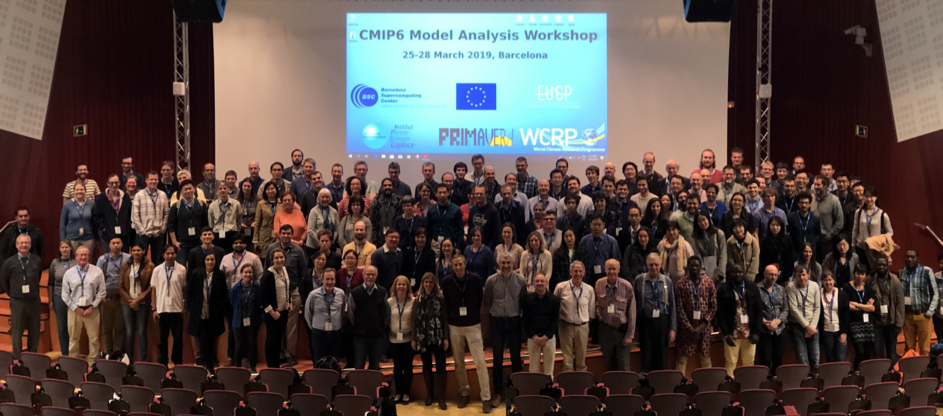9 April 2019
Under the auspices of the World Climate Research Programme (WCRP) Working Group on Coupled Modelling (WGCM), hundreds of climate researchers in modelling centres around the world are working to share, compare and analyse the latest results of global climate and Earth system models. Within the Coupled Model Intercomparison Project (CMIP), now in its 6th phase, project simulations of the research community provide model output that will fuel climate research and climate impact studies for the next 5 to 10 years, while its careful analysis will form the basis for future climate assessments. More than 40 climate modelling centres worldwide are expected to participate in CMIP6 and some early results are now available, which have been discussed at the first CMIP6 Model Analysis Workshop held in Barcelona, Spain, from 25-29 March 2019.
“I’m really excited to see the outcome of these first CMIP6 simulations. It is amazing how collaborative the scientific community is, and with the community-driven design of CMIP6, I expect we will make considerable progress on understanding how the Earth system responds to forcing, on identifying origins and consequences of systematic model biases, and on providing robust climate projections under different future scenarios that fill critical gaps compared to those used in CMIP5”, says CMIP Panel Chair Veronika Eyring from the German Aerospace Center (DLR). “This will include significant advances in our process understanding, supported by newly available evaluation tools that allow a more rapid and comprehensive evaluation of the models with observations”, says WGCM co-chair Cath Senior from the MetOffice Hadley Center in the UK.
At the time of the workshop, the CMIP6 archive included results from 12 modelling groups. As more modelling groups complete their simulations, the archive will become an increasingly rich resource for climate researchers. Based on new physical insights and newly available observations, many improvements have been made to models from CMIP5 to CMIP6, including changes in the representation of physics of the atmosphere, ocean, sea-ice, and land surface. In many cases, changes in the detailed representation of cloud and aerosol processes have been implemented. This new generation of climate models also features increases in spatial resolution, as well as inclusion of additional Earth system processes and new components. These additional processes are needed to represent key feedbacks that affect climate change, but are also likely to increase the spread of climate projections across the multi-model ensemble.
The consequences of all these model developments are now being assessed via careful analysis of the CMIP6 model output. Early results suggest that a more detailed consideration of the role of nutrient availability on future uptake of anthropogenic CO2 by the terrestrial biosphere results in a larger fraction of anthropogenic CO2 remaining in the atmosphere. Another example is that global climate models with increased horizontal resolution show a significant reduction in some long-standing regional model errors in sea surface temperatures and precipitation. Together with improved realism of model-simulated weather variability, such as tropical and mid-latitude cyclones and blocking anticyclones, these improvements allow more reliable estimates of future changes in weather phenomena in a warming world.
One commonly-used measure of a climate model’s response to greenhouse gas forcing is the ‘Equilibrium Climate Sensitivity’ (ECS), which approximates the change in global mean surface air temperature associated with doubling of CO2 concentration in the atmosphere. Initial results show that while for several CMIP6 models the ECS is similar to their CMIP5 counterpart (from about 6 years ago), some have a higher ECS. It is important to note that ECS is not ‘prescribed’ by model developers, but rather, is a consequence of the interaction of many climate processes and feedbacks represented in the models. At this point it is too early to make definitive statements about the reasons for the increase in ECS seen in some of the models, and it is also too early to say how this will affect the overall multi-model projections of future climate change under different forcing scenarios. However, new methods and observations are available that can help to further constrain uncertainties in key climate feedbacks and projections. The climate science community is actively investigating these important topics and peer-reviewed papers are already underway.
As in past phases, CMIP-based science should prove invaluable to the Intergovernmental Panel on Climate Change (IPCC) as it prepares the Sixth Assessment Report, due for release in 2021. “The IPCC Assessment process relies on new understanding and new climate model results that are provided by CMIP. The availability of a coordinated multi-model ensemble, with output provided in a common format that is accessible to all, enables new research and up-to-date climate projections that are essential to inform national and international policy development,” said Gregory Flato, vice-chair, IPCC Working Group I and WGCM co-chair.
While the community engagement has been phenomenal, the growing demands for CMIP will require ongoing strong institutional support for basic CMIP activities, such as the creation of forcing datasets, the provision and archiving of CMIP products, and model developments. Most of CMIP coordination and collaboration so far occurs through the volunteered time of climate researchers which is becoming unsustainable as reliance on CMIP data increases.
The CMIP6 Model Analysis Workshop was hosted by the Barcelona Supercomputing Center (BSC), and was jointly organized by the WCRP CMIP Panel and the European Commission Horizon 2020 projects PRIMAVERA (PRocess-based climate sIMulation: AdVances in high-resolution modelling and European climate Risk Assessment), which simultaneously held its annual general assembly, and EUCP (European Climate Prediction system). The next CMIP6 Model Analysis Workshop is planned for 2021.
These links provide additional information:
- Workshop website: https://cmip6workshop19.sciencesconf.org
- CMIP6 overview: https://www.wcrp-climate.org/wgcm-cmip/wgcm-cmip6
- CMIP6 video: https://www.youtube.com/watch?v=WdRiYPJLt4o
- CMIP6 guides: https://pcmdi.llnl.gov/CMIP6/Guide/
- CMIP6 participating climate research groups: http://rawgit.com/WCRP-CMIP/CMIP6_CVs/master/src/CMIP6_institution_id.html
- CMIP6 data access: https://esgf-node.llnl.gov/projects/cmip6
- CMIP6 ESGF data holdings: https://pcmdi.llnl.gov/CMIP6/ArchiveStatistics/esgf_data_holdings
- CMIP evaluation tool results: https://cmip-esmvaltool.dkrz.de
Contacts:
 Participants of the CMIP6 Model Analysis Workshop held in Barcelona, Spain, in March 2019.
Participants of the CMIP6 Model Analysis Workshop held in Barcelona, Spain, in March 2019.

